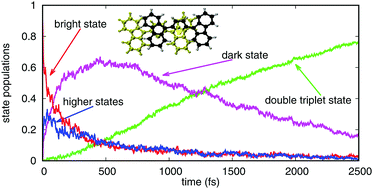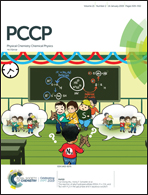Nonadiabatic dynamics simulations of singlet fission in 2,5-bis(fluorene-9-ylidene)-2,5-dihydrothiophene crystals†
Abstract
We present simulations of the singlet fission dynamics in 2,5-bis(fluorene-9-ylidene)-2,5-dihydrothiophene (ThBF), a thienoquinoid compound recently investigated experimentally by Kawata et al. The simulation model consisted of two ThBF molecules embedded in their crystal environment. The aim was to understand the singlet fission mechanism, and to predict the excited state lifetimes and the singlet fission quantum yield, hitherto unknown. The simulations were performed by the trajectory surface hopping approach with on-the-fly calculations of the electronic wave functions and energies by the semiempirical FOMO-CI method. We found that the initially photogenerated excitonic bright state decays to the lower dark state with a biexponential behaviour, essentially due to transitions to other close lying states. The dark state in turn decays with a lifetime of about 1 ps to the double triplet 1TT state, which is long-lived, as ascertained by performing a simulation with inclusion of the spin–orbit coupling. The singlet fission quantum yield is predicted to be close to the theoretical maximum of 200%. In view of using this thienoquinoid compound in photovoltaic devices, a major drawback is the low energy of the T1 state at its equilibrium geometry.



 Please wait while we load your content...
Please wait while we load your content...